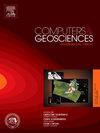MAMCL: Multi-attributes Masking Contrastive Learning for explainable seismic facies analysis
IF 4.2
2区 地球科学
Q1 COMPUTER SCIENCE, INTERDISCIPLINARY APPLICATIONS
引用次数: 0
Abstract
Seismic facies analysis is crucial in hydrocarbon exploration and development. Traditional machine learning approaches typically require manual selection of attributes and lack interpretability analysis. We propose an interpretable framework, multi-attribute masking contrastive learning (MAMCL), designed to adaptively select, explore and aggregate seismic attributes for seismic facies analysis. The MAMCL framework includes a depthwise CNN module for feature extraction and an iTransformer module for feature aggregation. Based on the assumption that different attributes computed on the same seismic sample imply common information associated with the same geologic facies, we formulate an unsupervised strategy of contrastive learning to pre-train the MAMCL framework for refining the attributes. This pre-training method encourages the network to extract and integrate highly correlated attribute features by enhancing the expression of commonalities within the same sample, and implicitly increase the distance between features of different categories by differentiating the expressions of different samples. Ultimately, these refined features only need to be input into a simple clustering algorithm, such as K-Means, to achieve seismic facies classification. MAMCL requires no labels or manual selection of attributes and can utilize the self-attention mechanism of iTransformer to compute adaptive attribute weights, facilitating interpretability analysis. We applied MAMCL framework to both unlogged turbidite channel systems in Canterbury Basin, New Zealand, and logged Chengdao area in Bohai Bay Basin, China, achieving reliable classification results and providing interpretability analysis.
MAMCL:用于可解释地震剖面分析的多属性屏蔽对比学习
地震剖面分析在油气勘探和开发中至关重要。传统的机器学习方法通常需要人工选择属性,缺乏可解释性分析。我们提出了一种可解释性框架--多属性掩蔽对比学习(MAMCL),旨在为地震剖面分析自适应地选择、探索和聚合地震属性。MAMCL 框架包括一个用于特征提取的深度 CNN 模块和一个用于特征聚合的 iTransformer 模块。基于对同一地震样本计算的不同属性意味着与同一地质面相关的共同信息这一假设,我们制定了一种无监督的对比学习策略,对 MAMCL 框架进行预训练,以完善属性。这种预训练方法通过增强同一样本内共性的表达,鼓励网络提取和整合高度相关的属性特征,并通过区分不同样本的表达,隐式地增加不同类别特征之间的距离。最终,只需将这些细化特征输入 K-Means 等简单聚类算法,即可实现地震剖面分类。MAMCL 不需要标签或人工选择属性,并可利用 iTransformer 的自注意机制计算自适应属性权重,从而促进可解释性分析。我们将 MAMCL 框架应用于新西兰坎特伯雷盆地的未测井浊积岩河道系统和中国渤海湾盆地的测井成岛地区,取得了可靠的分类结果,并提供了可解释性分析。
本文章由计算机程序翻译,如有差异,请以英文原文为准。
求助全文
约1分钟内获得全文
求助全文
来源期刊

Computers & Geosciences
地学-地球科学综合
CiteScore
9.30
自引率
6.80%
发文量
164
审稿时长
3.4 months
期刊介绍:
Computers & Geosciences publishes high impact, original research at the interface between Computer Sciences and Geosciences. Publications should apply modern computer science paradigms, whether computational or informatics-based, to address problems in the geosciences.
 求助内容:
求助内容: 应助结果提醒方式:
应助结果提醒方式:


